November 21, 2025 | 22:24 GMT +7
November 21, 2025 | 22:24 GMT +7
Hotline: 0913.378.918
November 21, 2025 | 22:24 GMT +7
Hotline: 0913.378.918
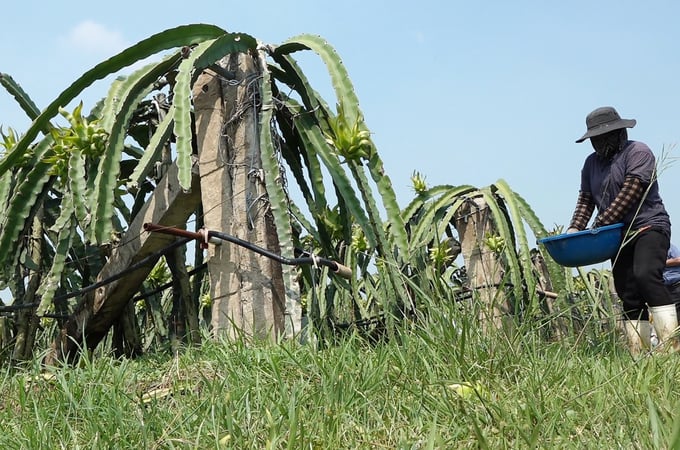
Not only must it ensure competitiveness and increase value, dragon fruit production must also contribute to reducing emissions in production. Photo: TL.
“Vietnam’s agriculture is facing many difficulties and challenges from internal issues as well as objective factors. It is time for Vietnam to transform the food system in general and the dragon fruit value chain in particular to a higher form, integrating green development and adaptation to climate change,” said Nguyen Do Anh Tuan, Director of the Department of International Cooperation (Ministry of Agriculture and Rural Development).
Understanding the struggles of Vietnamese dragon fruit, Ministry of Agriculture and Rural Development (MARD) as well as localities, associations, domestic and international organizations, businesses and cooperatives have taken actions to "reclaim the throne" for this fruit, striving to develop a sustainable, green and low-emissions industry, thereby conquering the 100-million-people domestic market and dominating the international market.
For the past three years, the United Nations Development Program (UNDP) has implemented the project "Promoting private investment in low-carbon agriculture adaptive to climate change, contributing to the implementation of Vietnam's NDCs". In the case of Binh Thuan, the program has helped dragon fruit growing cooperatives follow the direction of sustainable development and low-emissions production, notably Thuan Tien Dragon Fruit Cooperative, Hoa Le Clean Dragon Fruit Cooperative, Ham Kiem Dragon Fruit Production and Service Cooperative, and Ham Minh 30 Dragon Fruit Production and Service Cooperative.
Phan Van Tan, Deputy Director of Binh Thuan Department of Agriculture and Rural Development said, “Cooperatives in the province have grasped the benefits of lơ-emissions production, reflected in the reduction of electricity costs and many other production costs, thus improving economic efficiency while limiting risks of pest and disease”.
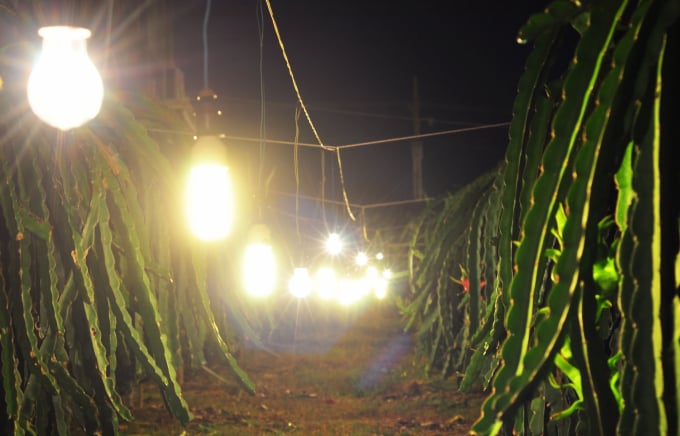
Compact light bulbs consume a lot of electricity, which is a major factor in increasing emissions in dragon fruit production, so growing dragon fruit using LED lights is considered a great alternative. Photo: Kim So.
According to Vu Tan Phuong, Director of the Sustainable Forest Management Certification Office (Vietnam Forest Certification Scheme), agriculture in general and the dragon fruit industry in particular need to meet increasingly strict market requirements in order to actively participate in the global food supply chain.
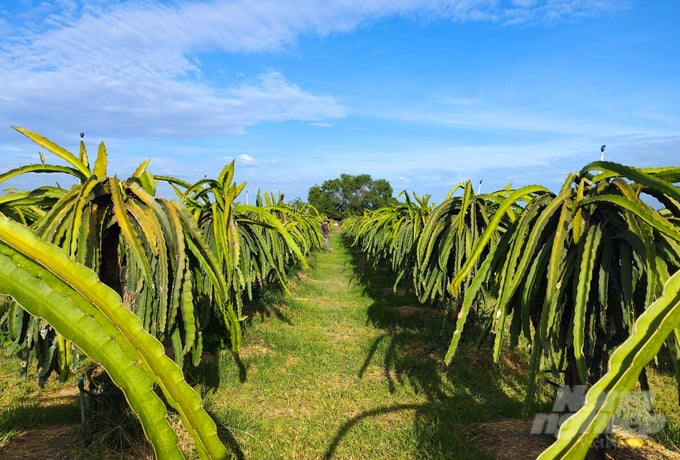
Organic dragon fruit production models are widely applied by farmers at present.
Vietnam's dragon fruit production needs to change throughout the low-emissions chain. Phase 1 (first 2 years, not yet harvested) is from the beginning of creating the dragon fruit garden, preparing the land, burying the poles, fertilizing, watering, and caring for. Phase 2 starts from the third year onwards (harvest phase). During this process, orchards still require fertilization, care, and the use of a lot of inputs. Phase 3 is transportation, preliminary processing, and processing.
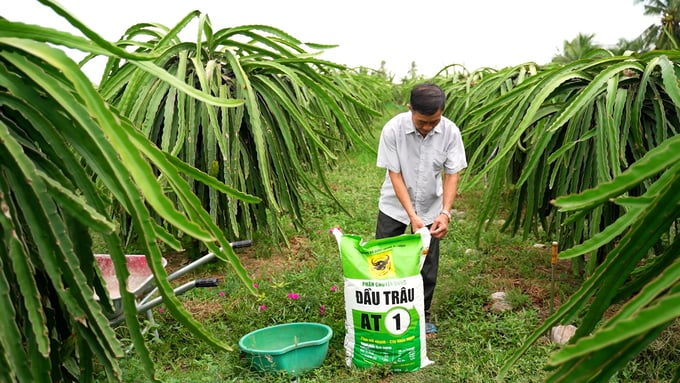
Using fertilizer scientifically will not only give the highest efficiency and limit waste, but also contribute to reducing emissions.
Director Phuong also mentioned the ever-changing characteristics of market demands, information technology, and the state of commerce. Digitalization and information transparency need to be present throughout the production chain while ensuring traceability as per customer’s demand.
Local functional branches must manage the entire production system to grasp the production situation and proactively make changes and adjustments accordingly. This will help make issues related to "carbon footprint" transparent, ensuring sustainable development in the value chain.

Unscientific and wasteful fertilization is still common in Vietnam’s dragon fruit production scene.
At the recent conference "Sustainable Dragon Fruit Development in Vietnam" jointly organized by the Department of International Cooperation and UNDP, Deputy Minister of Agriculture and Rural Development Tran Thanh Nam affirmed the competitive advantage of Vietnamese dragon fruit is the climate, soil and production process. “If you make full use of this advantage and do the dragon fruit production process well, Vietnam can confidently compete with any other country on the world market”.
MARD’s stance is not to increase the growing area, instead maintain it at 60,000 - 65,000 ha and an overall output of 1.3 - 1.5 million tons per year. Quality will be of first priority, supported by advanced production processes to ensure food safety and product traceability.
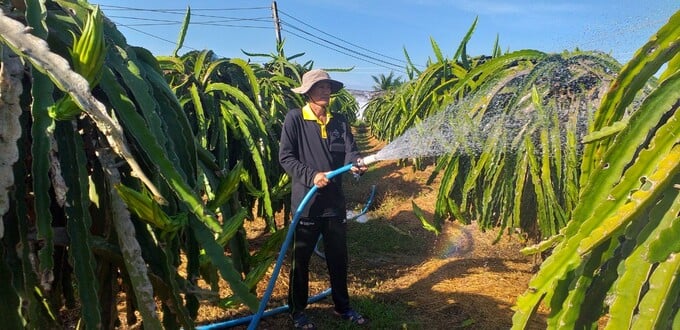
Vietnamese dragon fruit has great advantages in terms of climate and crop rotation period.
Deputy Minister Tran Thanh Nam said, “In order to orient sustainable dragon fruit production towards carbon credits, UNDP can integrate its activities with supportive acts for community agricultural extension forces and provincial agricultural extension centers to improve their capacity, through which they can help local farmers.
He requested UNDP to gather the results achieved from projects which are being implemented in Vietnam. The Ministry of Agriculture and Rural Development will then gain the basis to submit to the Government a program to reduce greenhouse gas emissions in the dragon fruit value chain.
Translated by Samuel Pham

(VAN) Results from the Sustainable Durian Model Project in Dak Lak have confirmed the critical role of Yara Viet Nam in transferring advanced nutritional solutions to farmers.

(VAN) In Tuyen Quang province, livestock farmers have introduced effective models and innovative practices that significantly strengthen African Swine Fever prevention and control efforts.

(VAN) This is the study conducted by IRRI and Can Tho University on the rice straw value chain in Mekong Delta showing an economic potential of more than 6.6 trillion VND/year.

(VAN) By participating in cooperative economics, many farmers in Tay Ninh have overcome hardship, mastered clean dragon fruit cultivation techniques.

(VAN) The crossbreeding program in the former Binh Dinh province (now part of Gia Lai) has shown signs of decline, and urgent measures are needed to revive it and sustain past achievements.

(VAN) The agricultural sector agreed on a roadmap to pilot the MRV protocol and expand low-emission rice production from the 2025-2026 winter-spring crop.

(VAN) Agricultural extension officers in Quang Ninh do more than transmit knowledge; they have become a steadfast support system for farmers on the path to sustainable agricultural development.